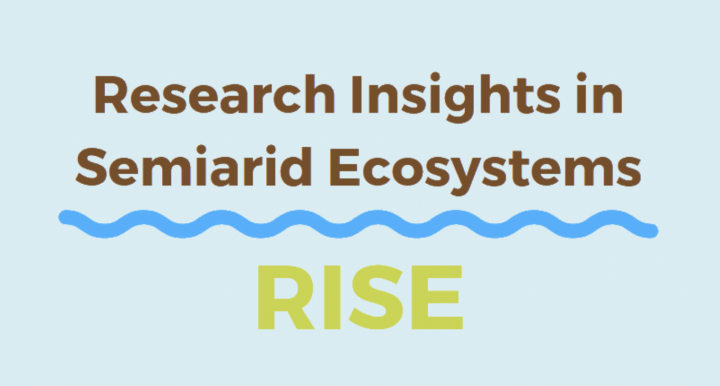Arid Lands & Resources
One-fifth of the world’s population lives in arid lands, which encompass nearly one-third of the Earth’s total land surface. Arizona Environment facilitates interdisciplinary research and solutions to the complex interactions between ecological, economic and socio-cultural factors that put pressure on arid lands.
The UArizona provides a unique interdisciplinary environment for researchers and students to engage in the study of arid and semi-arid landscapes, and has created a collaborative environment rich in faculty expertise in the physical, biological resource, agricultural and social sciences. Arid Lands research encompasses an array of topics including international development, famine, food security, land use, land degradation, political-ecology, agricultural policy, borderlands issues and urban development. The Arid Lands Resource Sciences graduate program has over 60 affiliated faculty from 19 departments who are committed to enhancing our understanding of arid lands and to find innovative solutions faced by arid lands around the globe.
Research Spotlights in Arid Lands & Resources
Stefanie Hermmann
Agricultural and Biosystems Engineering
Hermann investigates techniques for incorporating local land user perspectives in assessing and understanding land degradation in drylands of the developing world.
Learn moreDon Slack
Agricultural and Biosystems Engineering
Slack’s work focuses on the cultivation and processing of sorghum in arid regions for use in ethanol production.
Learn moreNeng Fan
Systems and Industrial Engineering
Fan works on sustainable techniques for optimizing the biomass supply chain and feedstock logistics for the production of biofuels and bioproducts made from guar and guayule (a natural rubber suitable for growing in arid environments).
Learn moreWilliam Smith
School of Natural Resources and the Environment
Smith is developing remote sensing techniques and strategies for monitoring the spatiotemporal dynamics of dryland ecosystem structure and function.
Learn more
APMC is an umbrella organization within the College of Agriculture and Life Sciences, whose goal is to create a working environment in which the science and implementation of Integrated Pest Management can thrive in Arizona.
Read more
ASRC works on wide range of international, national, regional, and local projects in which advanced airborne and satellite remote sensing data and other geospatial information technologies are utilized to help address both fundamental and applied issues in natural resource management.
Read more
Arizona State Museum’s expansive collections are among the most notable resources in the world for research and study of Native peoples of the American Southwest and northern Mexico that cuts across many disciplines, including archaeology, ethnology, ethnohistory, materials science, climate science, and related fields.
Read more
The UA-led Santa Catalina Mountains and Jemez River Basin Critical Zone Observatory aims to improve understanding of the function, structure, and co-evolution of biota, soils, and landforms that comprise the critical zone by examining and measuring geomorphic, hydrologic, and biogeochemical interactions within it.
Read more
The mission of CESM is to develop educational, specialized professional training, and research initiatives that address environmental issues related to mining activities in arid and semi-arid urban environments.
Read more
The Desert Laboratory on Tumamoc Hill is a culturally important 860-acre ecological preserve in Tucson, conducting environmental studies which include physiology, ecology, restoration ecology, and arid lands.
Read more
The Desert Research Unit performs basic and applied research to evaluate and promote methods for reclamation of water and land in arid and semiarid environments.
Read more
DSCESU is a UA-based cooperative network of federal, university, and non-governmental agencies studying and managing natural and cultural resources across California, Nevada, Arizona, New Mexico, and Texas, with emphasis on involving communities and under-represented groups.
Read more
The Tree-Ring Lab is recognized worldwide as a preeminent center for the advancement of tree-ring techniques and the broad application of dendrochronology in the social and environmental sciences.
Read more
The NPC conducts interdisciplinary research leading to the discovery and development of useful natural products from plants and micro-organisms.
Read more
The Southwest Center seeks to define, illuminate, and present, through research, teaching, and publishing, the character of the Greater Southwest: the heartland of Arizona, New Mexico, Sonora, and Chihuahua, and its peripheries.
Read more
The SW CASC provides objective scientific information, tools, and techniques that land, water, wildlife, and cultural resource managers and other interested parties can apply to anticipate, monitor, and adapt to climate change impacts in the southwestern U.S.
Read more
The SBAR Center of Excellence works to optimize and integrate the production of guayule and guar to enable the Southwest U.S. to significantly impact biofuel and other high-value product markets and to improve quality of life in rural communities and Native Nations.
Read more
ARIZ is a research collection of over 400,000 dried plant specimens, with emphasis on the plants of the Sonoran Desert region and adjacent areas of the southwestern United States and northwestern Mexico.
Read more
Located on the grounds of the College of Architecture, Planning and Landscape Architecture building on the UA campus, the Underwood Family Sonoran Landscape Laboratory represents the reclamation of 1.2 acres of former university parking lot into a viable Sonoran Desert landscape, with high-performance integration of the building and site. It demonstrates low-cost arid land design principles of water harvesting, water reuse, mitigation of desert microclimates and reduction and re-direction of runoff for passive and active storage as well creating an enchanting desert oasis.
Read more
The Yuma Center of Excellence for Desert Agriculture (YCEDA) is an innovative public-private partnership that addresses high-priority issues identified by industry stakeholders to improve all aspects of desert crop production systems and economics.
Read more




